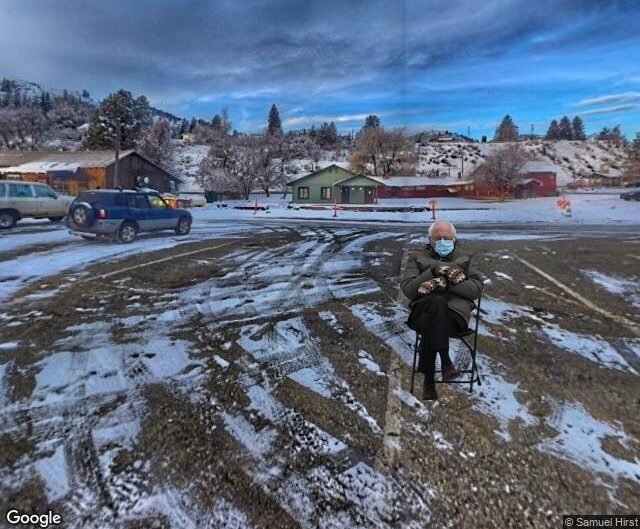By now, you've no doubt seen a few dozen — or several thousand — of the creative memes featuring Bernie's Chair. Or is it properly thought of as Bernie's Mittens? Maybe we need an art naming contest: "Bernie on a Chair in Jacket and Mittens." Has the echo of "Girl with a Pearl Earring."
(For the three of you who don't know what I'm talking about: It's a super-viral send-up of U.S. Senator Bernie Sanders, built on a photo of him sitting in isolation on a folding chair at the U.S. presidential inauguration last week, huddled in a workaday gray jacket and wearing fat mittens recycled from an old sweater by a Vermont schoolteacher.)
It wasn't a nano-second until several someones had developed plug-and-play apps of the photo. Bernie and his mittens had soon made it around the world tens of millions of times, dressed as is or tarted up in everything from Green Bay Packers gear to whipped cream. He was draped in a Guadalupe cape and used as a pattern on a Melania Trump dress. (When I tried to share the latter on Facebook, it was bounced as a violation of community standards. Not sure why: It was a very modest dress.)
No way am I going to dare to designate a favorite. I just want them to keep rolling in. For now, I'm just happy that Rolling Stone scored an interview with the photographer who snapped the original photo.
Brendan Smialowski is a former sports photojournalist from Connecticut who now covers politics for Agence France-Presse. He was at the U.S. Capitol during the insurrectionist assault on January 6, then back for the inauguration January 20. He spoke to Rolling Stone about why and how he grabbed an image of Sanders in a candid moment.
As a writing journalist who made marginal photos when I was working alone, I was especially interested in Smialowski's answer about how many shots he took that resulted in the Bernie meme (emphasis is mine):
I've probably learned more about reporting and writing from working in the field with photographers than from anything else. This reinforced one of the core lessons: composition comes second to content. It's not that literary elegance or creative flair don't matter — but they need to serve the story, not override it.
(For the three of you who don't know what I'm talking about: It's a super-viral send-up of U.S. Senator Bernie Sanders, built on a photo of him sitting in isolation on a folding chair at the U.S. presidential inauguration last week, huddled in a workaday gray jacket and wearing fat mittens recycled from an old sweater by a Vermont schoolteacher.)
It wasn't a nano-second until several someones had developed plug-and-play apps of the photo. Bernie and his mittens had soon made it around the world tens of millions of times, dressed as is or tarted up in everything from Green Bay Packers gear to whipped cream. He was draped in a Guadalupe cape and used as a pattern on a Melania Trump dress. (When I tried to share the latter on Facebook, it was bounced as a violation of community standards. Not sure why: It was a very modest dress.)
No way am I going to dare to designate a favorite. I just want them to keep rolling in. For now, I'm just happy that Rolling Stone scored an interview with the photographer who snapped the original photo.
Brendan Smialowski is a former sports photojournalist from Connecticut who now covers politics for Agence France-Presse. He was at the U.S. Capitol during the insurrectionist assault on January 6, then back for the inauguration January 20. He spoke to Rolling Stone about why and how he grabbed an image of Sanders in a candid moment.
As a writing journalist who made marginal photos when I was working alone, I was especially interested in Smialowski's answer about how many shots he took that resulted in the Bernie meme (emphasis is mine):
This exact moment, I took two photos. It’s funny because the second one — for me — I thought was better. But I sent the first one because the moment — his posture, his pose — is a little better. But the composition was garbage. It was messy, but it was a better moment. I always say that in photojournalism, composition comes second to content. And content is the moment. Make it look pretty after. If I can’t put it together in a way that looks really good, with every piece of the picture adding, that’s okay. It’s more important to get the moment and then keep shooting if you can make it better.
I've probably learned more about reporting and writing from working in the field with photographers than from anything else. This reinforced one of the core lessons: composition comes second to content. It's not that literary elegance or creative flair don't matter — but they need to serve the story, not override it.



